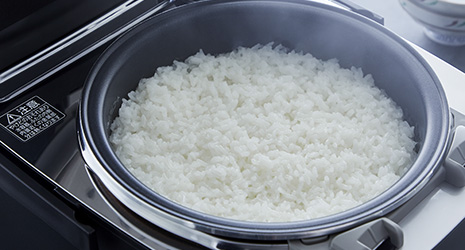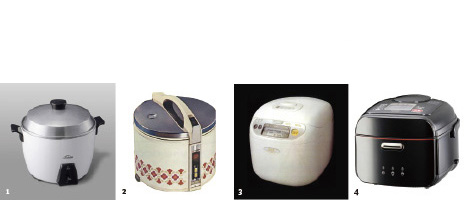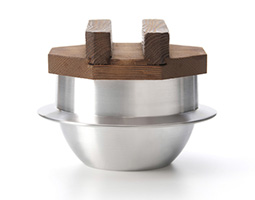INDEX
- English
- 日本語

Freshly cooked rice in a rice cooker - English
- 日本語

1 Japan’s first automatic electronic rice cooker (1955)
2 Jar rice cooker that can keep the rice warm (1972)
3 A pressure IH rice cooker (1992)
4 IH jar rice cooker for high heating with charcoal in the inner pot (2006)

An iron pot (hagama) of the type once used to cook rice on a kamado
November 2020
The Evolution of the Rice Cooker

From the traditional kamado stove to the induction heating “jar,” the rice cooker continues to evolve.

Until the mid-1960s, most Japanese households cooked rice using a kamado, a type of firewood fueled oven. The polished rice is washed in water, left to stand for a while, then heated in an iron pot (hagama) with a wooden lid and is ready within the hour. There is a saying that goes something like, “The heat is low at first, then it gets hotter. When steam blows out, turn down the heat. Don’t remove the lid, even if the baby cries.” That is, you should let the rice absorb the water at low heat in the first step and then cook it at high heat in the second step, followed by a gradual lowering of the temperature and finally a constant temperature for steaming. This is the Japanese way of cooking delicious rice. The part saying “Don’t remove the lid, even if the baby cries” reflects the wisdom that you won’t get lustrous rice unless the steaming is done properly.
Rice cooking is important work for any household, but it used to be laborious and put a heavy burden on housewives in the past. As TVs, fridges, washing machines, and other home electronics became more prevalent in the 1950s, the “automatic electric rice cooker” made its appearance in 1955. Initially, there were those who doubted it, asking, “Can you cook rice with an electric device?” Yet the convenience of automatically cooking rice without hassle at the flip of a switch became popular and spread to households across the country. According to a survey by Central Research Services, Inc., the household ownership rate of rice cookers was 19.6% in 1959, 55.2% in 1969, over 90% in 1971, and more than 95% after 1980, thus becoming a common sight nationwide.

2 Jar rice cooker that can keep the rice warm (1972)
3 A pressure IH rice cooker (1992)
4 IH jar rice cooker for high heating with charcoal in the inner pot (2006)
Since the Japanese are quite particular about how they want their rice to taste, it is not enough for the rice cooker to just be able to cook rice, automatically. Overseas, rice usually means long and narrow indica rice; in Japan, despite a circulation of more than 820 types (brands) of domestic rice (2019 production), the vast majority is a type of japonica that is short and nearly round. Japonica rice is characterized by its stickiness and sweetness, qualities which are brought out through proper cooking. Rice cooker makers took on this challenge and won the support of households.
The makers then incorporated more electronic technology to make continuous improvements. For example, the “jar rice cooker” that can keep the rice warm after cooking was released on the market in 1972, and the “micro-controller jar rice cooker” that can adjust heating according to rice volume became available in 1979, with both products boosting popularization. What was truly ground-breaking for the rice cooker was the IH (induction heating) rice cooker, which made its debut in 1988. Earlier electric micro-controller rice cookers were warmed from a heater at the bottom of the inner pot, but IH allowed for the entire pot to be kept on high heat by controlling the strength of the current flowing through an IH coil. This evolved further so that rice can be cooked “hard,” “normal,” and “soft,” according to preference. The pressure IH rice cooker appeared in 1992, making it possible to cook delicious brown rice and millet rice, responding to prevailing health trends. This broadened the range of cooking techniques, and cookers now come with more than 100 cooking settings.
The eating habits of the Japanese are becoming more diverse—for example, bread consumption is increasing—but the desire for “delicious rice” has not changed. The makers continue to work hard on developing their products in pursuit of that deliciousness, adjusting how the rice is cooked by changing the material of the inner pot, the heating method, and so forth.
Yasuko, a Tokyo resident who remembers cooking rice with a kamado as a child, laughs that it’s possible to cook delicious rice with a kamado, but adds, “I grew up in a rice-growing district in the northeast, so I care about how the rice should taste. I do get a real feeling of how the rice cooker has developed when I prepare rice. Now we can enjoy not just white rice but also brown rice and rice cooked with other ingredients. The main thing is, eating delicious rice together is a family’s greatest pleasure.”
Japanese rice cooker makers are active not only in Japan but also in other countries, mainly in Asia. They are developing rice cookers suitable for rice produced in each country, and are currently engaged in local production and export. The accumulation of techniques for Japanese rice cooker development over sixty-five years is now helping people to cook delicious rice in many other countries.


